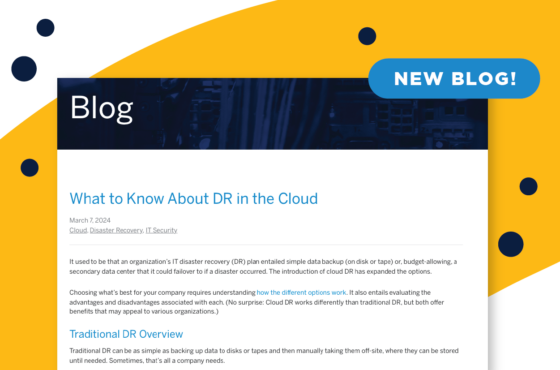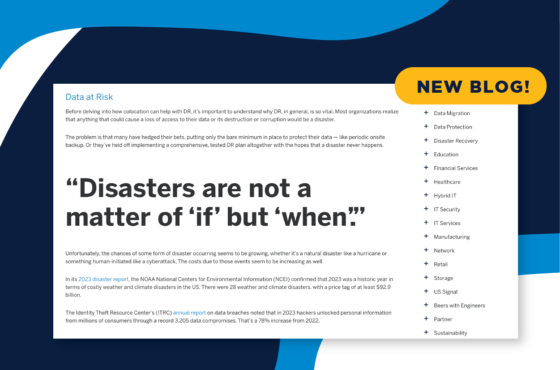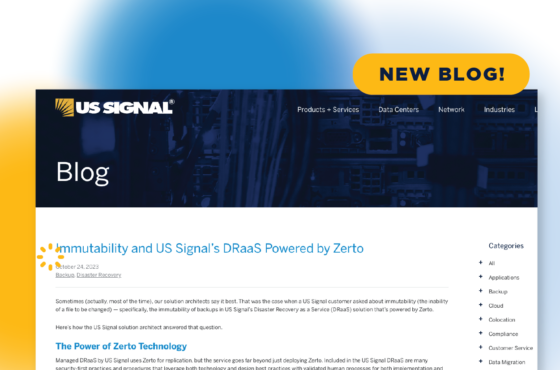5 Tips For Winterizing Your Disaster Recovery Plan
December 13, 2018
Disaster Recovery
The Potential Impact of Winter Weather on Disaster Recovery (DR) Plans
Weather can be unpredictable, and winter power outages seem to happen regardless of weather forecasts. Winter weather events can impact your business' continuity in several ways that should be built into your disaster recovery plan:
- A single ice storm or heavy winds can down powerlines and cause a power outage, resulting in potential downtime and data loss for businesses
- Heavy snow accumulation and ice dams on buildings can cause leaks or bring roofs down, damaging essential IT infrastructure
- Difficult road conditions may delay the response time of emergency services, increasing the potential scope of damage of disasters like fires
Disaster Recovery Plan Winterization Tips
It’s not enough to have a DR plan in place. It must be able to stand up to the unique risks associated with winter weather. It needs to be regularly tested so that it performs as expected if a disaster strikes. It also needs to be resilient.
The following tips can help you make sure your DR plan is winter ready and ready to perform.
1. Consider Telecommuting Options & BYOD Policies for Employees
Chances are you have employees who are essential to keeping your critical business functions operating. If severe winter weather keeps them from being on-site, make sure they are equipped with the necessary resources to conduct business or access specific systems or data from wherever they are.
Choose the most secure methods for remote access. Frequently test connections and processes so that if a disaster strikes, everything is set to go.
Restrict access to only the data deemed necessary to each employee’s job. Implement advanced security technologies and training to help protect data from intentional or unintentional insider breaches.
2. Prioritize Uptime Maintenance of Your Website
Keep your website running so you can use it to inform stakeholders apprised of the status of your business during a severe winter storm.
Measures such as cloud services can help ensure you always have scalable resources to cost-effectively meet traffic demands.
Cloud services can also power security mechanisms that defend your website against cyber-attacks. A secure, reliable network is a must as well.
3. Regularly Back Up Your Data and Applications
This is a must any time of the year, but can be especially important when winter storms threaten to take down your IT infrastructure.
Backup copies should be updated frequently and stored in the cloud or at an offsite location to ensure you have access to them if your facility is damaged by a storm or hazardous conditions prevent you from being on site. There are several backup methods to use. Make sure to select the one that best meets your organization’s business requirements.
4. Protect Your Physical Infrastructure
This is an involved and extremely important consideration for winterization of your disaster recovery plan. Here are some items to consider and implement:
- Maintain an uninterrupted power supply to help prevent data loss and potential damage to your hardware.
- Have surge protectors on all network appliances.
- If your company requires zero downtime, make sure you have access to a secondary source of power such as a generator to keep critical systems running.
- If you rely on internet connections for cloud computing, customer support systems, or anything else, consider getting service from at least two different providers using diverse paths to enter your facilities.
- If your utilities use the same path, consider wireless backups or at least use different technologies.
Better yet, consider moving your infrastructure to a colocation or cloud services provider that provides the requisite connectivity, redundancies, cooling, and power supplies. These types of vendors must deal with severe winter weather as well, but the good ones among them are prepared to do so. If you go this route, make sure you understand your organization’s requirements for security and uptime and that the vendor can meet them.
5. Consider a Disaster Recovery as a Service (DRaaS) solution.
Even with winter weather already underway, it’s never too late to hand off the replication and hosting of physical or virtual servers to a third-party that can provide failover in the event of a winter-related catastrophe, as well as any kind of man-made or natural disaster.
DRaaS solutions can be especially useful for small- to mid-size businesses that lack the expertise and resources to provision, configure and test an effective DR plan.
It’s a managed service offered on a contract or pay-per-use basis, meaning that there is no need to invest in or maintain your own off-site DR environment.
The requirements are documented in a service-level agreement (SLA), so you know what to expect. Some DRaaS solutions also include regular testing and customized DR playbooks.
Weather the Winter Storms with US Signal's DRaaS Solutions
There’s no escaping winter storms in most parts of the United States, but your business doesn’t have to suffer when extreme winter conditions occur. Your disaster recovery plan is meant to help you weather whatever Mother Nature sends your way.
To help determine your readiness for a disaster any time of the year, download US Signal’s DR Checklist. It can help you identify areas of weakness in your current DR strategy, and prepare you for developing a more comprehensive, resilient plan.
US Signal’s solution architects are also available to evaluate your current DR plan or, if you don’t have one, to create a customized solution to meet your company’s specific DR needs. For information or to speak with our team about managed disaster recovery services, contact us today to get started.
Additional Disaster Recovery Resources
To learn more about disaster recovery and managed DR services, check out these articles below from our blog or visit our resource center for whitepapers, e-books and more!


